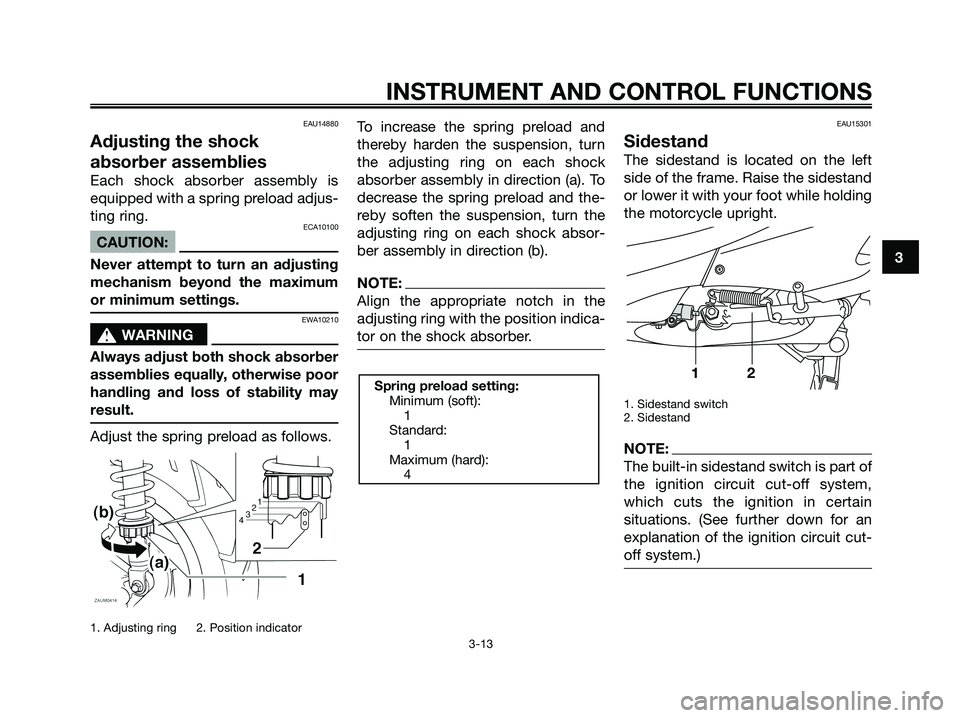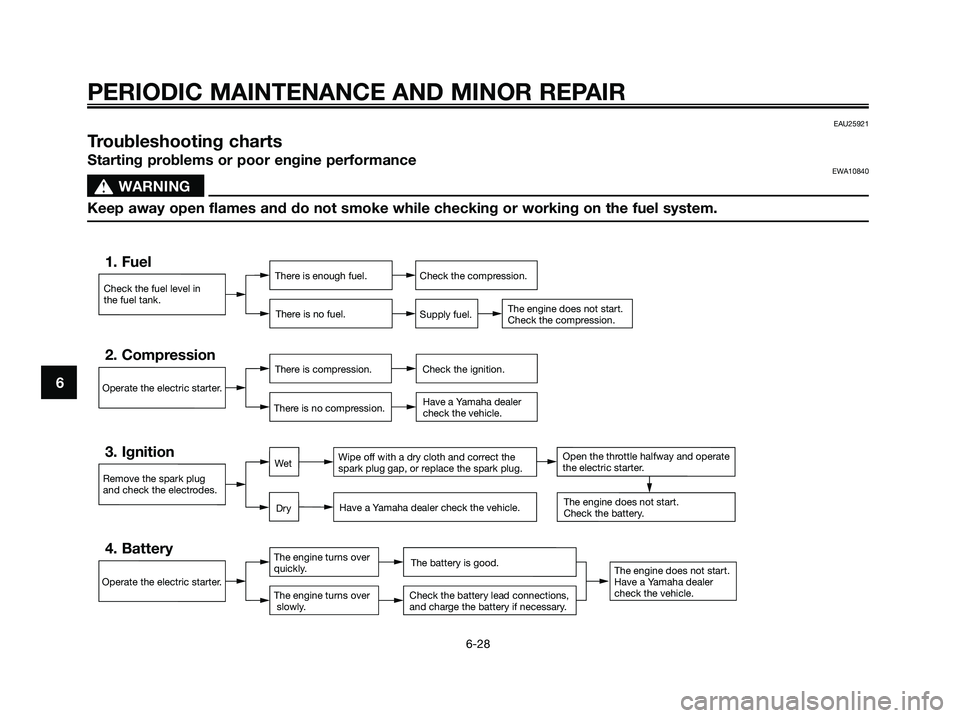Page 16 of 76

EAU10471
Main switch/steering lock
The main switch/steering lock con-
trols the ignition and lighting systems,
and is used to lock the steering.
NOTE:
Be sure to use the standard key
(black bow) for regular use of the
vehicle. To minimize the risk of losing
the code re-registering key (red bow),
keep it in a safe place and only use it
for code re-registering.
EAU10550
ON
All electrical circuits are supplied with
power, the meter lighting, taillight,
license plate light and auxiliary lights
come on, and the engine can be star-ted. The key cannot be removed.
NOTE:
The headlights come on automatically
when the engine is started and stay
on until the key is turned to “OFF”,
even if the engine stalls.
EAU10660
OFF
All electrical systems are off. The key
can be removed.
EAU10680
LOCK
The steering is locked, and all electri-
cal systems are off. The key can be
removed.
T
o lock the steering
1. Turn the handlebars all the way to
the left.
2. Push the key in from the “OFF”
position, and then turn it to
“LOCK” while still pushing it.
3. Remove the key.
T
o unlock the steering
Push the key in, and then turn it to
“OFF” while still pushing it.
EWA10060
s s
WARNING
Never turn the key to “OFF” or
“LOCK” while the vehicle is
moving, otherwise the electrical
systems will be switched off, which
may result in loss of control or an
accident. Make sure that the vehi-
cle is stopped before turning the
key to “OFF” or “LOCK”.
3
INSTRUMENT AND CONTROL FUNCTIONS
3-2
1B9-F8199-E1.qxd 9/10/06 09:59 Página 3-2
Page 27 of 76

EAU14880
Adjusting the shock
absorber assemblies
Each shock absorber assembly is
equipped with a spring preload adjus-
ting ring.
ECA10100
CAUTION:
Never attempt to turn an adjusting
mechanism beyond the maximum
or minimum settings.
EWA10210
s s
WARNING
Always adjust both shock absorber
assemblies equally, otherwise poor
handling and loss of stability may
result.
Adjust the spring preload as follows.
1. Adjusting ring 2. Position indicator
To increase the spring preload and
thereby harden the suspension, turn
the adjusting ring on each shock
absorber assembly in direction (a). To
decrease the spring preload and the-
reby soften the suspension, turn the
adjusting ring on each shock absor-
ber assembly in direction (b).
NOTE:
Align the appropriate notch in the
adjusting ring with the position indica-
tor on the shock absorber.
EAU15301
Sidestand
The sidestand is located on the left
side of the frame. Raise the sidestand
or lower it with your foot while holding
the motorcycle upright.
1. Sidestand switch
2. Sidestand
NOTE:
The built-in sidestand switch is part of
the ignition circuit cut-off system,
which cuts the ignition in certain
situations. (See further down for an
explanation of the ignition circuit cut-
off system.)
12Spring preload setting:
Minimum (soft):
1
Standard:
1
Maximum (hard):
4
3
INSTRUMENT AND CONTROL FUNCTIONS
3-13
1B9-F8199-E1.qxd 9/10/06 09:59 Página 3-13
Page 28 of 76
EWA10240
s s
WARNING
The vehicle must not be ridden with
the sidestand down, or if the sides-
tand cannot be properly moved up
(or does not stay up), otherwise the
sidestand could contact the ground
and distract the operator, resulting
in a possible loss of control. Yama-
ha’s ignition circuit cut-off system
has been designed to assist the
operator in fulfilling the responsibi-
lity of raising the sidestand before
starting off. Therefore, check this
system regularly as described
below and have a Yamaha dealer
repair it if it does not function pro-
perly.
3
INSTRUMENT AND CONTROL FUNCTIONS
3-14
1B9-F8199-E1.qxd 9/10/06 09:59 Página 3-14
Page 32 of 76
4
PRE-OPERATION CHECKS
4-3
ITEM CHECKS PAGE
Brake levers• Make sure that operation is smooth.
• Lubricate lever pivoting points if necessary.3-9, 6-20
Centerstand, sidestand• Make sure that operation is smooth.
• Lubricate pivots if necessary.6-20
Chassis fasteners• Make sure that all nuts, bolts and screws are properly tightened.
• Tighten if necessary.—
Instruments, lights, signals • Check operation.
and switches• Correct if necessary.—
Sidestand switch• Check operation of ignition circuit cut-off system.
• If system is defective, have Yamaha dealer check vehicle.3-13 ~ 3-15
1B9-F8199-E1.qxd 9/10/06 09:59 Página 32
Page 59 of 76

3. Fully charge the battery before
installation.
4. After installation, make sure that
the battery leads are properly
connected to the battery termi-
nals.
ECA10630
CAUTION:
�Always keep the battery char-
ged. Storing a discharged bat-
tery can cause permanent bat-
tery damage.
�To charge a sealed-type (MF)
battery, a special (constant-
voltage) battery charger is
required. Using a conventional
battery charger will damage
the battery. If you do not have
access to a sealed-type (MF)
battery charger, have a Yamaha
dealer charge your battery.
EAU23610
Replacing the fuses
The main fuse and the fuse box,
which contains the fuses for the indi-
vidual circuits, are located behind
cowling B. (See page 6-6.)
If a fuse is blown, replace it as
follows.
1. Turn the key to “OFF” and turn off
the electrical circuit in question.
2. Remove the blown fuse, and then
install a new fuse of the specified
amperage.ECA10640
CAUTION:
Do not use a fuse of a higher ampe-
rage rating than recommended to
avoid causing extensive damage to
the electrical system and possibly a
fire.
3. Turn the key to “ON” and turn on
the electrical circuit in question to
check if the device operates.
4. If the fuse immediately blows
again, have a Yamaha dealer
check the electrical system.
Specified fuses:
Main fuse:
30 A
Headlight fuse:
15 A
Signaling system fuse:
15 A
Ignition fuse:
5 A
Clock fuse (backup):
5 A
Radiator fan fuse:
10 A
6
PERIODIC MAINTENANCE AND MINOR REPAIR
6-23
1B9-F8199-E1.qxd 9/10/06 09:59 Página 59
Page 63 of 76

ECA11190
CAUTION:
Do not overtighten the screw,
otherwise the lens may break.
EAUS1260
Replacing the auxiliary light
bulb
If the auxiliary light bulb burns out,
replace it as follows.
1. Remove cowling B . (See page
6-6.).
2. Remove the socket (together
with the bulb) by pulling it out.
3. Remove the defective bulb by
pulling it out.
4. Insert a new bulb into the socket.
5. Install the socket (together with
the bulb) by pushing it in.
6. Install the cowling B.
EAU25880
Troubleshooting
Although Yamaha scooters receive a
thorough inspection before shipment
from the factory, trouble may occur
during operation. Any problem in the
fuel, compression, or ignition sys-
tems, for example, can cause poor
starting and loss of power.
The following troubleshooting charts
represent quick and easy procedures
for checking these vital systems your-
self. However, should your scooter
require any repair, take it to a Yamaha
dealer, whose skilled technicians
have the necessary tools, experience,
and know-how to service the scooter
properly.
Use only genuine Yamaha replace-
ment parts. Imitation parts may look
like Yamaha parts, but they are often
inferior, have a shorter service life and
can lead to expensive repair bills.
6
PERIODIC MAINTENANCE AND MINOR REPAIR
6-27
1B9-F8199-E1.qxd 9/10/06 09:59 Página 63
Page 64 of 76

6
PERIODIC MAINTENANCE AND MINOR REPAIR
6-28
EAU25921
Troubleshooting charts
Starting problems or poor engine performanceEWA10840
s s
WARNING
Keep away open flames and do not smoke while checking or working on the fuel system.
Check the fuel level in
the fuel tank.
1. FuelThere is enough fuel.
There is no fuel.Check the compression.
Supply fuel.
The engine does not start.
Check the compression.
Operate the electric starter.
2. CompressionThere is compression.
There is no compression.Check the ignition.
Have a Yamaha dealer
check the vehicle.
Remove the spark plug
and check the electrodes.
3. IgnitionWipe off with a dry cloth and correct the
spark plug gap, or replace the spark plug.
Have a Yamaha dealer check the vehicle.
The engine does not start.
Have a Yamaha dealer
check the vehicle.
The engine does not start.
Check the battery.
Operate the electric starter.
4. BatteryThe engine turns over
quickly.
The engine turns over
slowly.The battery is good.
Check the battery lead connections,
and charge the battery if necessary.
Dry
We tOpen the throttle halfway and operate
the electric starter.
1B9-F8199-E1.qxd 9/10/06 09:59 Página 64
Page 71 of 76

Operation
Centrifugal automatic type
ChassisFrame type
Steel tube underbone
Caster angle
28 º
Trail
100 mm (3.94 in)
Front tireType
Tubeless
Size
120/70-15 M/C 56P or 56S
Manufacturer/model
Michelin / Gold Standard
Pirelli / GTS23
Rear tireType
Tubeless
Size
140/70-14 M/C 68P or 68S
Manufacturer/model
Michelin / Gold Standard
Pirelli / GTS24
LoadingMaximum load
189 kg (417 lb)
Load is total weight of the equipement, dri-
ver, passenger and accessories
Tire air pressure (measured on cold
tires)
Loading condition
0–90 kg (0–198 lb)Front
190 kPa (27 psi) (1.9 kgf/cm
2)
Rear
220 kPa (31 psi) (2.2 kgf/cm
2)
Loading condition
90 kg (198 lb)–Maximum load
Front
210 kPa (30 psi) (2.1 kgf/cm
2)
Rear
250 kPa (36 psi) (2.5 kgf/cm
2)
Front wheelWheel type
Aluminium wheel
Rim size
15 x MT3.5
Rear wheelWheel type
Aluminium wheel
Rim size
14 x MT3.75
Front brakeType
Single disc brake
Operation
Right hand operation
Recommended fluid
DOT 4
Rear brakeType
Single disc brake
Operation
Left hand operation
Recommended fluid
DOT 4
Front suspensionType
Telescopic fork
Spring/shock absorber type
Coil spring/oil damper
Wheel travel
94 mm (3.70 in)
Rear suspensionType
Unit swing
Spring/shock absorber type
Coil spring/oil damper
Wheel travel
83 mm (3.27 in)
Electrical systemIgnition system
Transistorized coil ignition (digital)
Charging system
AC magneto
BatteryManufacturer/model
GS/GTX9 BS
Voltage, capacity
12 V, 8.0 Ah
Bulb voltage, wattage x quantityHeadlight
12 V, 35.0 W / 35.0 W x 2
Auxiliary light
12 V, 5.0 W x 2
Tail/brake light
12 V, 21.0 W / 5.0 W x 2
Front turn signal light
12 V, 10.0 W x 2
8
SPECIFICATIONS
8-2
1B9-F8199-E1.qxd 9/10/06 09:59 Página 71